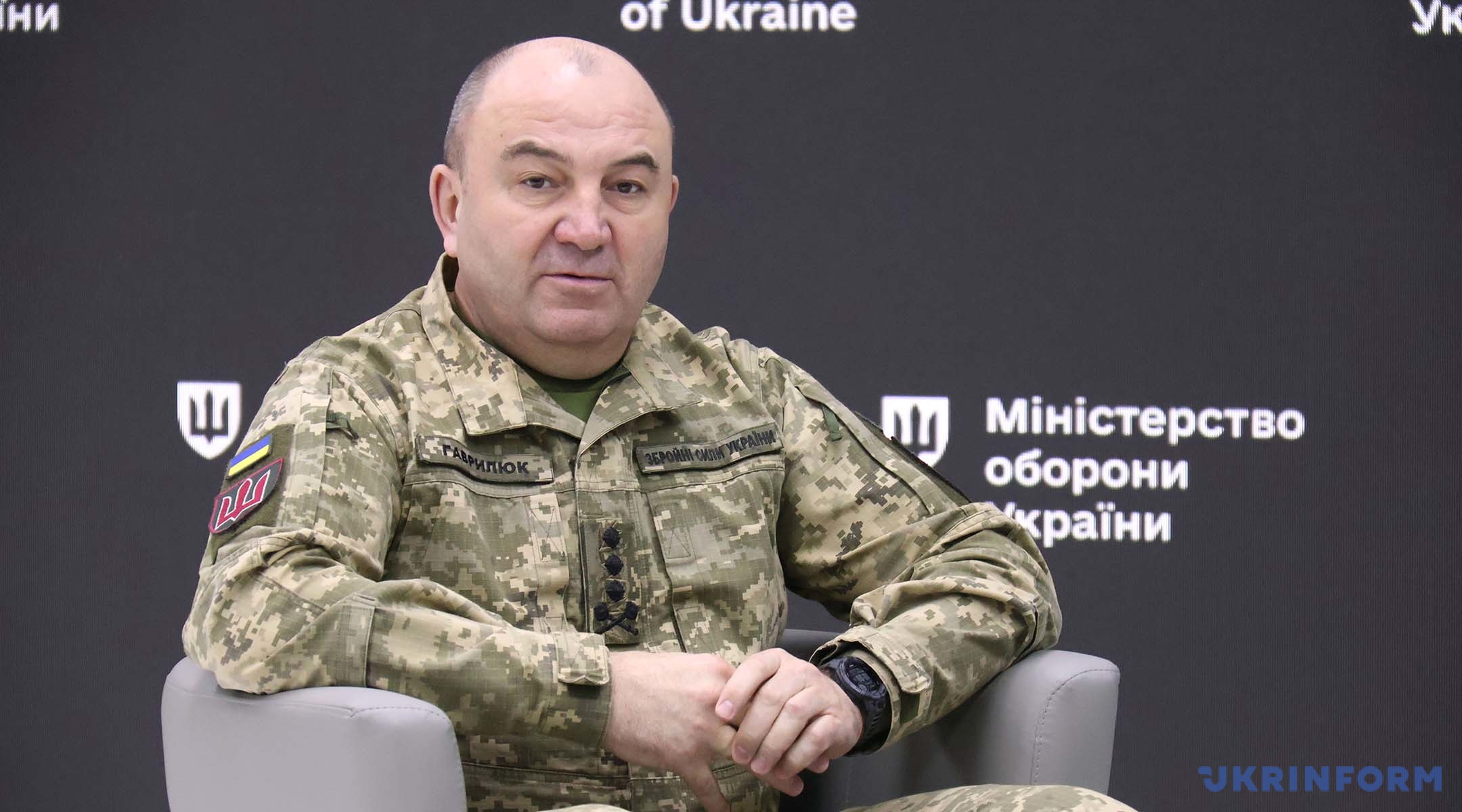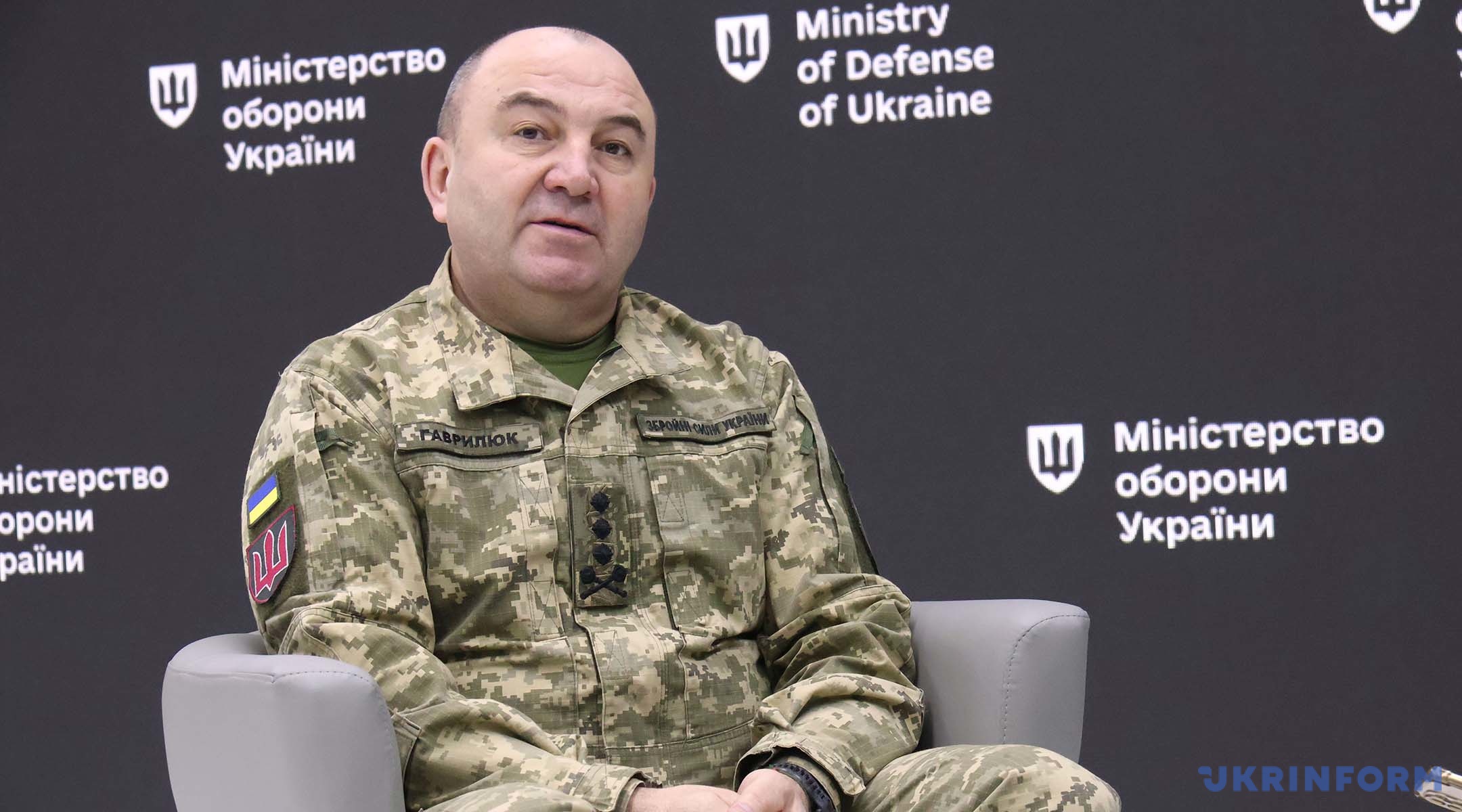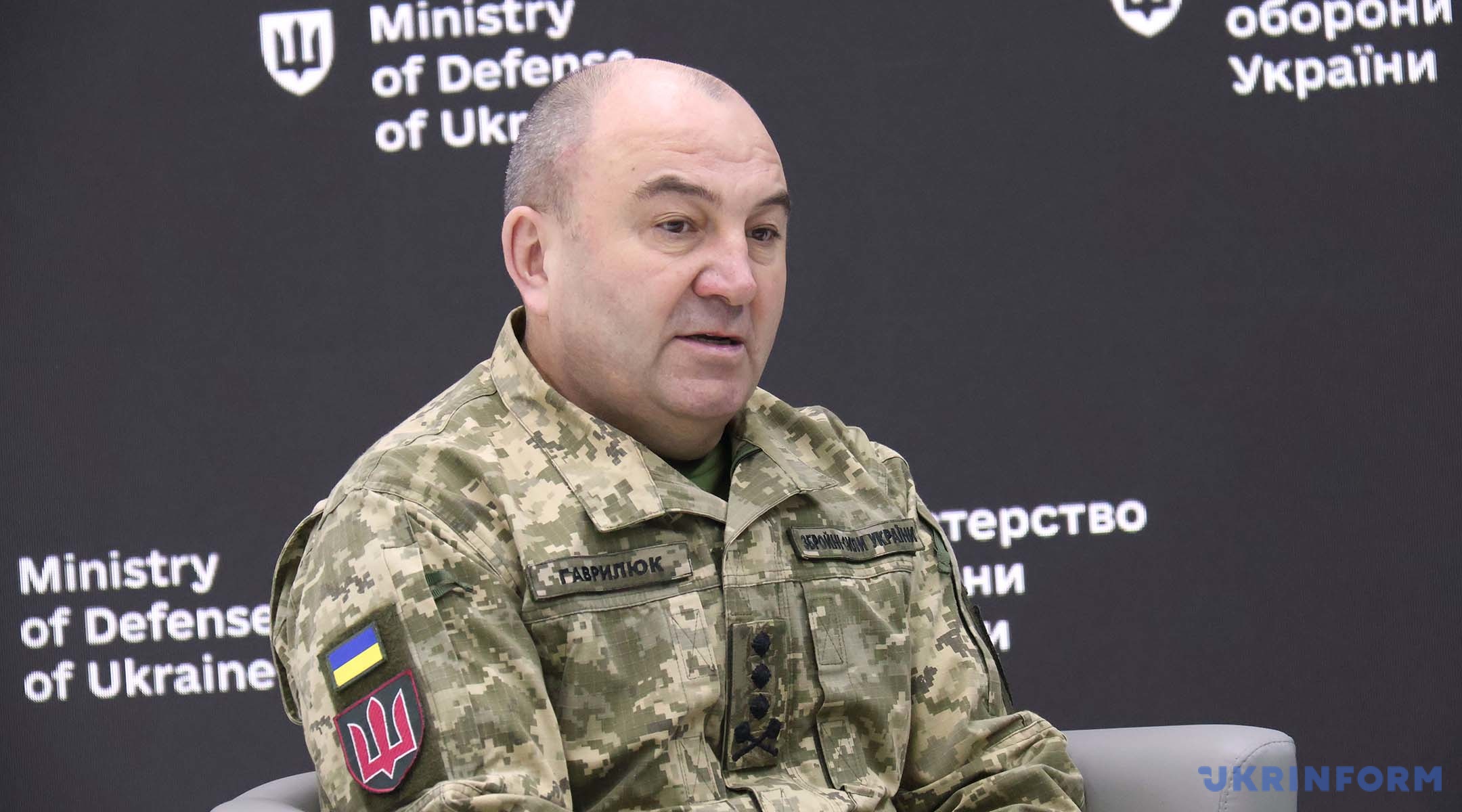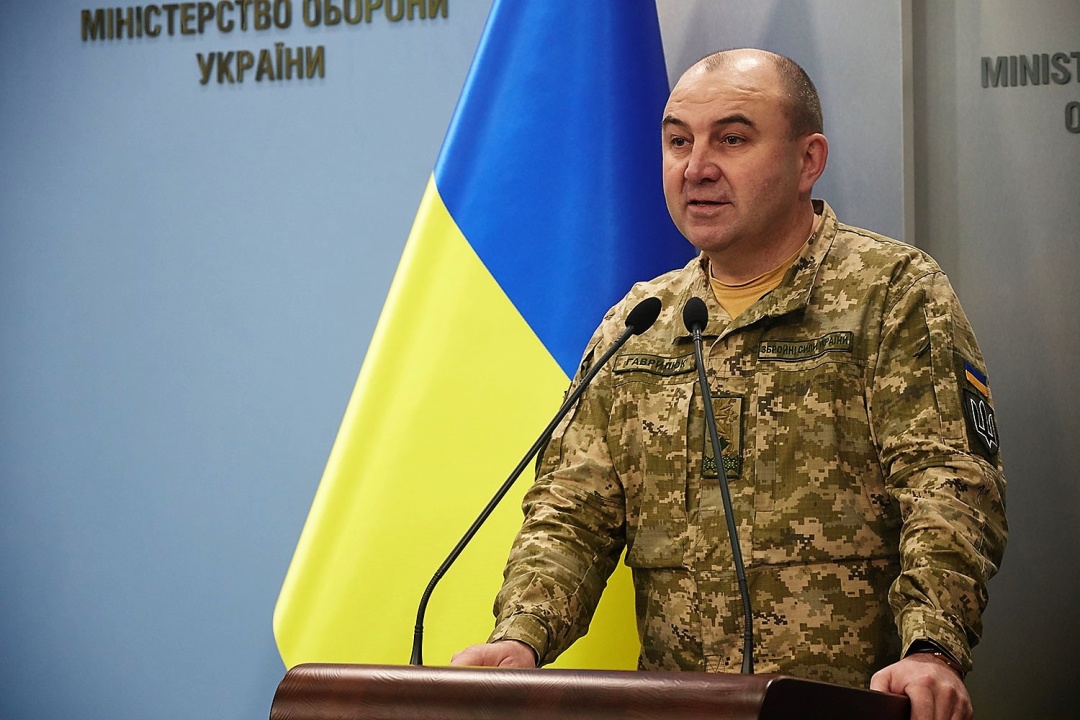February 24 marked three years since Russia launched its full-scale invasion of Ukraine. Every day of these three years is full of pain, trials, but at the same time hope and unshakable faith in Victory. How have the battlefield tactics transformed over this time, how powerful Russia’s defense industry remains today, whether Putin will conduct a general mobilization in March, and to what extent international assistance meets the needs of the Defense Forces of Ukraine is discussed in this interview by Ukrinform with First Deputy Minister of Defense of Ukraine, Lieutenant General Ivan Havryliuk.

DECEMBER 2024 SAW THE CULMINATION OF THE ENEMY’S OFFENSIVE ACTIVITY
- I would like to start our conversation with an analysis of the situation on the battlefield and how the tactics of combat operations have changed over these three years.
- Basically, this question should better be asked to top leaders of the Armed Forces of Ukraine, the Commander-in-Chief. From myself, I can say that a difficult time and the culmination of the enemy’s offensive activity fell on the end of 2024, in December. Individual days saw record high numbers of combat clashes exceeding 250 per day, the highest number of 292 clashes being recorded for December 15. This is a lot! Therefore, there was an enormous burden on our Defense Forces, our defenders.
I would like to remind you that every day Russian aircraft drop an average of a hundred precision KAB glide bombs on our defensive positions and near the frontline cities. The enemy spends at least a third of this amount, sometimes about a half, in its Kursk region, in a bid to push our forces out of their positions there. The massive use of KAB bombs is one of the main means the enemy employs to enable its infantry to advance. For that matter, I would remind you that Russians launched approximately 40,000 precision glide bombs against Ukrainian defensive positions and near the frontline cities during 2024.
That being said, units of the Defense Forces of Ukraine inflict significant losses in manpower on the Russian forces. In particular, in January, the Russian army lost 48,240 soldiers killed and wounded, and December 2024 saw the record high personnel losses inflicted on the Russian military for all the three years of Russia’s all-out invasion of Ukraine when its lost 48,670 soldiers dead and injured.
But here I want to emphasize that Russia failed to achieve its strategic objectives on any of the sectors of the Front Line, despite the fierce pressure, numerical superiority in manpower and in many types of materiel, and dominance in the sky.
- How has the nature of hostilities altered, and can we say that all military textbooks will have to be rewritten to suit the modern warfare realities?
- War should not be considered exclusively in an academic context, as a fixed set of specific axioms. With the emergence of new means of destruction on the battlefield, the nature of warfare is changing quite dynamically. We see how the role of the latest means of war conduct - unmanned systems of various classes and for various purposes - has been rapidly growing recently. We see how the means and techniques of warfare have evolved to adapt to changes in the means of warfighting. In fact, unmanned aerial vehicles began to be actively used as a weapon of destruction in the second half of 2023 and saw massive use both by Ukrainian and Russian forces beginning in 2024. That being said, specifications and capabilities of any particular unmanned aerial vehicle type need to be updated every three months or even more frequently as the adversary is improving its anti-drone warfare tactics. That is, this is a never-ending dynamic process of improving weapons of destruction and means of counteraction. He who does this work faster, invests more in the development of drone technologies, will have an edge over the opponent.
UNMANNED AERIAL SYSTEMS AND RELATED MUNITIONS MAKE UP THE MAJORITY OF ALL THE NEW WEAPONS PRODUCTS CODIFIED AND DEPLOYED BY UKRAINE
- Is it true to say that Ukrainian drone technologies surpass Russian rivals in quantity and quality?
- In terms of first-person-view (FPV) drone production, Ukraine currently surpasses the Russian Federation. The drone production sector in Ukraine is developing very rapidly, both in terms of innovation and manufacturing. Since February 24, 2022, more than 1,300 new models of weapons and military equipment produced by Ukrainian enterprises have been codified for the Defense Forces, the majority of them being unmanned aerial systems and related ammunition. Last year alone, more than 250 new UAV models were approved for operational use in the Defense Forces. It is important to understand that the key factor is not just the number of drones developed and manufactured.
The most crucial aspects are the effectiveness and efficiency of their operational deployment and the speed at which developers can respond to evolving battlefield conditions and adversary capabilities. You could have hundreds of thousands of drones, but they would be powerless against the enemy’s countermeasures. In the drone production sector, within a span of one to three months, the effectiveness of a particular model can decline. It is essential to continuously find new ways to maintain effectiveness and efficiency. The technological “duel” between drone manufacturers and anti-drone technology developers is a vivid illustration of this dynamic. The advantage belongs to those whose engineers can quickly offer technological solutions that leave the enemy without an immediate countermeasure. Take, for example, drones using elements of artificial intelligence, or the increasingly frequent use of fiber optic controlled drones in response to the dominance of electronic warfare technologies.

UKRAINE DEPLOYED 65 NEW MODELS OF GROUND ROBOTIC SYSTEMS IN 2024
- How is everything progressing with the production of ground robotic platforms? How many new weapons products have been codified and deployed recently?
- Last year, around 65 models of ground robotic platforms of various types and purposes were codified and deployed, almost all of them developed and manufactured domestically in Ukraine.
The fact is that, given Russia’s military superiority over Ukraine, it is unrealistic it can be defeated head-on in a straightforward way. It is therefore crucial that asymmetric responses be found to balance out this superiority. I mean particularly the massive use of ground robotic platforms.
Nowadays, unmanned ground vehicles can be employed to perform a wide range of missions on the battlefield -- conduct reconnaissance and intelligence gathering, deliver ammunition, evacuate wounded casualties from the battlefield, place and remove mines.
Our soldier - a machine gunner, a sapper, a logistician -- needs to be replaced with a robot wherever possible.
Last year, we intensively worked on an innovative project that involves the integrated use of ground and air robotic and unmanned systems to perform particular combat missions within the overall structure of tactical formations. This particularly includes the deployment of robot command posts, employing unique experience and expertise of Ukrainian defense industries and IT specialists.
There are already instances of robotic units being deployed on the battlefield.
Moreover, a specialized training center was set up in 2024 to train robot operators, providing training in control of ground robotic vehicles integrated with weapon mounts, cargo, engineering and other platforms, in coordinated missions with unmanned aerial vehicles for battlefield surveillance and taking out hostile targets.
- Without international assistance, Ukraine would not have been able to hold out and fight the enemy for so long. How has the amount of the assistance changed over these three years?
- Since April 2022, I have been leading the Ukraine group at the NATO Security Assistance and Training for Ukraine (NSATU) mission, headquartered in Wiesbaden, Germany.
At that time, more than 40 countries, both within and outside of NATO, were providing assistance to Ukraine.
The amount of assistance provided to Ukraine in 2022 is incomparabe to what we received in 2023–2024. I am talking particularly about artillery ammunition and weapons systems of various types. In terms of armored vehicles, most of them were provided [by partners] to the Ukrainian Defense Forces in 2023.
As you may know, many of our partners hesitated to give Ukraine weapons of some particular type. But we managed to convince them that we are determined to fight on and are able to learn the weapons they provide very quickly. Later on, our soldiers demonstrated this during training abroad on specific types of weapons.
The range of weapons and equipment from allies that the Defense Forces are now employing on the battlefield is quite extensive.
SOME 70 PERCEN OF WHAT IS DEPLOYED ON THE BATTLEFIELD COME FROM INTERNATIONAL AID
- Could you give the percentage of Ukraine’s arms and military equipment requirement provided through international assistance?
- There are concepts such as the full requirement for conducting combat operations of maximum intensity and the required minimum for conducting defensive operations, for example. The full requirement has never been fully met. Approximately 70 percent of what the Defense Forces deploy on the battlefield has come through international military assistance.
We are currently requiring aid from our partners, especially in terms of the provision of the types of armaments that we do not produce domestically or produce in insufficient quantities. In particular, this is about air defense systems, heavy armored vehicles, and NATO-standard caliber artillery shells.
But that being said, our domestic ammunition manufacturers are ramping up their production volumes and expanding the range of new weapons and military equipment products they produce. Government’s defense purchases are increasingly prioritizing domestic industries. Last year, for instance, approximately two-thirds of armaments procurement contracts for the Armed Forces of Ukraine were awarded to domestic industries. We have managed to reduce our dependence on imports, particularly of special-purpose armored vehicles, and Ukraine is moving towards self-sufficiency in the production of war drones.
I would like to highlight the production of long-range drones. I think you regularly see news reports describing the results of strikes on the aggressor's military targets. Long-range strike drones are currently serving as a kind of replacement for long-range missiles.
Ukraine’s government is currently placing an increased emphasis on the speedy implementation of domestic programs for the production of long-range weapons – missiles and unmanned aerial vehicles. These are the weapons that will make a strong argument for Ukraine. We need weapons of defense and deterrence.

RUSSIA STILL RETAINS THE CAPACITY TO MANUFACTURE ALMOST THE FULL RANGE OF ARMAMENTS
- Information about the true situation in the Russian defense industrial sector is very hard to find for obvious reasons. Perhaps you have this information from intelligence sources.
- At the time Russia launched its all-out war aggression against Ukraine, more than 1,300 different defense industries were operating in Russia, employing almost two million people. This is a formidable mechanism for waging a war. Russia still retains the capacity to manufacture almost all major types of armaments. That said, there is information that Russian defense industries are lacking hundreds of thousands of competent professionals. This shortage arose from the fact that Russia began to spin up its weapons production volumes, and quite significantly. Production of armaments has jumped three to six-fold in some categories. Today, Russia retains leadership in production of Warsaw Pact standard artillery shells among other weapons.
That said, however, Russia’s defense industrial sector is unable to meet all the needs and requirements of its frontline forces, forcing it to relay on supplies from North Korea and Iran.
A separate issue is the production of drones in Russia. Our adversary has appreciated the potential this weapon holds in modern warfare. The development of this type of weapon is therefore the targeted priority area. Russia exploits its strengths attributed a totalitarian regime, including generous funding and the use of broad opportunities for rapid deployment of production lines. For example, to manufacture copies of Iranian Shahed drones, they quickly deployed mass production in a specific economic zone.
Additionally, the Russians keep looking for new ways to improve the existing domestic UAV technologies, both for attack and reconnaissance missions, with emphasis placed on mass production.
- Does it suggest they have already emptied their stocks of Soviet-era weapons and military equipment, or is this an illusive hope?
- I cannot say what they have in stock, but what I can say is that a significant portion of the weapons and military equipment stocks left behind by the USSR army in Europe in the late 1980s and early 1990s, particularly by the Western and Southern Groupings of Forces, was moved for storage to facilities located in the Russian Federation. Some part of the stocks was perhaps supplied or exported to foreign countries, but the stockpile still remains very large.
We are currently observing certain signs indicating that the Russian Federation is facing shortages or other problems with the availability of major weapon and equipment systems. Thay have to send mostly Soviet-era vehicles to the Front Line instead of modern tanks. The same holds true for artillery gun systems and multiple launch rocket systems. But even obsolete weapons are still weapons. Even T-62s or T-55s are still tanks. The aggressor’s logic is simple – not to waste money on something that can be taken out from old stocks at a certain stage. The focus is on quantity.
Furthermore, outdated models of equipment require less amount of training for weapons and vehicle crews. There is either no electronic components contained there at all, making the weapons simple to operate, and therefore easier and faster to learn.
IN 2024, AT LEAST 427,000 CONTRACT SOLDERS WILL BE RECRUITED INTO THE RUSSIAN ARMY
- Rumors have it that Russia is going to declare general mobilization in March…
- Basically, in Russia, mobilization has never stopped before and is continuing now, in the form of service under contract. The Russian Federation has switched to war footing, mobilizing its industries and creating a network of propaganda media for misinforming and zombifying its population, and this network is very effective today. This requires an enormous amount of work to be done at the political and diplomatic levels by all of the global community.
We see that Russia is seeking to recruit into its army more civilian prisoners, residents of the areas currently under its control, soldiers from North Korea, and mercenaries from across the world.
In 2024, Russia recruited at least 427,000 contracted soldiers into its armed forces, making the monthly average at 36,000. However, in the last quarter of 2024 and January 2025, the aggressor saw 40,000-plus casualties dead and wounded on Ukrainian battlefields every month. That is, the Russian army is in the red, unless you counted foreign mercenaries and North Korean soldiers... However, Russia still retains a huge mobilization capacity, with many citizens still enlisting, whether motivated by financial incentives or state propaganda.
If the world community shows indecision or weakness in joint actions against the Russian aggression, the Kremlin will definitely try to avail of this to achieve its propaganda objectives, at the diplomatic level and on the battlefield.

SEARCH FOR CALL-UP EVADERS IS THE JOB FOR LOCAL AUTHORITIES AND POLICE RATHER THAN MILITARY ENLISTMENT AND RECRUITMENT AUTHORITIES
- Let's move on to the sensitive topic such as mobilization in Ukraine. All responsibility for this is currently vested in military enlistment & recruitment (MER) authorities and the Police. However, this role is legislatively required to be performed by other government agencies in addition to those mentioned above.
- The issue of mobilization is rooted in the realities in which the Ukrainian society as a whole is living now. What do I mean? Our media outlets are more focused on negative aspects, pedaling forced narratives about "busification" and bad MER employees. We see more negativity than positivity from them regarding the need to defend the country and the State.
A significant number of Ukrainians are firm in their belief that mobilization is the job solely for the MER authorities. This is not so. The Law of Ukraine on "Mobilization Preparation and Mobilization" clearly defines all actors involved in that process, their duties and competencies.
Most of the duties related to mobilization are assigned to government bodies and the Police. For example, if a Ukrainian citizen liable for compulsory military service fails to show up at a MER office during the legal regime of martial law, then local authorities and the Police are supposed to ensure that he shows up. They are vested with sufficient authority to ensure compliance.
- But they deny having this authority.
- Enabling legislation specifies in clear terms the powers vested in local governments and the Police. They are fully aware that ensuring draft-liable persons turn up in a MER office is the duty of government bodies and the National Police, while the duty of Territorial MER Centers is to maintain draft records and select appropriate people to serve with the Defense Forces of Ukraine.
I emphasize once again that MER authorities are responsibly for only a part of mobilization measures. MER centers are not vested with powers to search for draft evaders. This is the job to be done by local authorities and the Police.
If a local government official fails to perform his official duties, that person is free to submit a letter of resignation. It is also necessary to conduct awareness campaigns among communities to explain the importance of defending the country. One must realize that, failing mobilization, we are going to lose the country. No matter how many robotic systems, weapons of destruction, or military equipment we have, this all is operated and controlled by a human being.
- In December, you announced a forthcoming reform of the MER network. What is this reform about?
- The reform is aimed to divide duties and responsibilities assigned to Territorial MER Centers into discrete components. For example, the first component - social issues - should be separated from others. The second component is the network of MER centers, responsible for keeping records of reservists and other persons liable for compulsory military service, calling them up for reserve training assemblies and boot camps. The third and final component will deal with preparing the population for service in the Armed Forces or units of the Security and Defense Forces. This function will also be separated from others.
- Legislators are often making PR on the issue of demobilization from military service. How do you view this problem?
- Lawmakers constantly ask this question at An Hour of Questions to the Government sessions of the Verkhovna Rada. I will answer it again.
According to the currently effective legislation, demobilization from military service cannot be declared until after the termination of the legal regime of martial law. Demobilization includes implementation of a host of measures. In order to define the duration of compulsory military service, replace soldiers who are currently performing tasks on the Front Line, it is necessary to compile a reserve of trained men.
War has simple mathematics: it requires new soldiers to replace those fighting on the frontline for a long time, those wounded or killed. We will not be able to avoid this. No one will fight instead of us. We need to replace a family member, a classmate, a neighbor, or a colleague at the front line... We all must appreciate this.
Interviewed by Iryna Kozhukhar
Photo courtesy of Pavlo Bakhmut and via the Author
